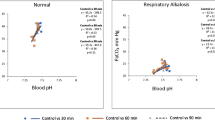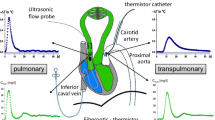Summary
Experiments were carried out in 12 dogs anesthetized with halothane of constant alveolar concentration (mean: 0.89%). The ventilatory response to arterial\(P_{{\text{CO}}_{\text{2}} } \) with hyperoxia was determined in metabolic acidosis (by infusion of 0.5 N HCl solution). The ventilatory response to arterial\(P_{{\text{CO}}_{\text{2}} } \) with constant hypoxia (about 50 mm Hg arterial\(P_{{\text{O}}_{\text{2}} } \)) was determined in both metabolic acidosis and alkalosis (by infusion of 1 M NaHCO3 solution).
The arterial H+-ventilation response curve was obtained at different constant levels of\(P_{{\text{CO}}_{\text{2}} } \) by simultaneous analysis of the\(P_{{\text{CO}}_{\text{2}} } \)-H+ diagram and the\(P_{{\text{CO}}_{\text{2}} } \)-ventilation response curve. Ventilation in hyperoxia was largely dependent on\(P_{{\text{CO}}_{\text{2}} } \) if acid-base balance was near normal, but became independent of\(P_{{\text{CO}}_{\text{2}} } \) and dependent on arterial H+ as this increased. It was postulated that this was partly due to the negative interaction between\(P_{{\text{CO}}_{\text{2}} } \) and H+. The H+-ventilation response curves showed the same pattern in hypoxia, but only on the alkalotic side. However, with hypoxia in the range of normal to acidotic condition, control of ventilation was mainly dependent on H+ and independent of\(P_{{\text{CO}}_{\text{2}} } \); this implies an interaction between hypoxia and H+ at the peripheral chemoreceptors.
Similar content being viewed by others
References
Beneken Kolmer, H. H., Kreuzer, F.: Continuous polarographic recording of oxygen pressure in respiratory air. Respir. Physiol.4, 109–117 (1968).
Bjurstedt, A. G. H.: Interaction of centrogenic and chemoreflex control of breathing during oxygen deficiency at rest. Acta physiol. scand.12, 1–88 (1946).
Bradley, R. D., Semple, S. J. G.: A comparison of certain acid-base characteristics of arterial blood, jugular venous blood and cerebrospinal fluid in man, and the effect on them of some acute and chronic acid-base disturbances. J. Physiol. (Lond.)160, 381–391 (1962).
Brandstater, B., Eger II, E. I., Edelist, G.: Constant-depth halothane anesthesia in respiratory studies. J. appl. Physiol.20, 171–174 (1965).
Burnap, T. K., Galla, S. J., Vandam, L. D.: Anesthetic, circulatory and respiratory effects of fluothane. Anesthesiology19, 307–320 (1958).
Chazan, J. A., Appleton, F. M., London, A. M., Schwartz, W. B.: Effects of chronic metabolic acid-base disturbances on the composition of cerebrospinal fluid in the dog. Clin. Sci.36 345–358 (1969).
Cormack, R. S., Cunningham, D. J. C., Gee, J. B. L.: The effect of carbon dioxide on the respiratory response to want of oxygen in man. Quart. J. exp. Physiol.42, 303–319 (1957).
Domizi, D. B., Perkins, J. F., Jr., Byrne, J. S.: Vnetilatory response to fixed acid evaluated by ‘iso-\(P_{{\text{CO}}_{\text{2}} } \)‘ technique. J. appl. Physiol.14, 557–561 (1959).
Eyzaguirre, C., Lewin, J.: Chemoreceptor activity of the carotid body of the cat. J. Physiol. (Lond.)159, 222–237 (1961).
Gemmill, C. L., Reeves, D. L.: The effect of anoxemia in normal dogs before and after denervation of the carotid sinuses. Amer. J. Physiol.105, 487–495 (1933).
Gesell, R., Lapides, J., Levin, M.: The interaction of central and peripheral chemical control of breathing. Amer. J. Physiol.130, 155–170 (1940).
Gray, B. A.: Response of the perfused carotid body to changes in pH and\(P_{{\text{CO}}_{\text{2}} } \). Respir. Physiol.4, 229–245 (1968).
Gray, J. S.: Pulmonary ventilation and its physiological regulation, pp. 1–82. Springfield: Ch. C. Thomas 1950.
Hamilton, R. W., Jr., Brown, E. B., Jr.: Carbon dioxide, oxygen, and acidity: The interaction and independent effects on breathing of these factors in the arterial blood. In: Report of USAF School of Aerospace Medicine, Aerospace Medical Division (AFSC), Brooks Air Force Base, pp. 1–42. Texas 1964.
Honda, Y., Natsui, T.: Effect of sleep on ventilatory response to CO2 in severe hypoxia. Respir. Physiol.3, 220–228 (1967).
——, Hasumura, N.: Analysis of ventilatory response to CO2 during hypoxia in dogs. J. appl. Physiol.20, 839–843 (1965).
Hornbein, T. F., Griffo, Z. J., Roos, A.: Quantitation of chemoreceptor activity: Interrelation of hypoxia and hypercapnia. J. Neurophysiol.24, 561–568 (1961).
—, Roos, A.: Specificity of H ion concentration as a carotid chemoreceptor stimulus. J. appl. Physiol.18, 580–584 (1963).
Jacobs, M. H.: The production of intracellular acidity by neutral and alkaline solutions containing carbon dioxide. Amer. J. Physiol.53, 457–463 (1920).
Joels, N., Neil, E.: The influence of anoxia and hypercapnia, separately and in combination, on chemoreceptor impulse discharge. J. Physiol. (Lond.)155, 45–46 (1961).
Katsaros, B., Loeschcke, H. H., Lerche, D., Schönthal, H., Hahn, N.: Wirkung der Bicabonat-Alkalose auf die Lungenbelüftung beim Menschen. Bestimmung der Teilwirkung von pH und CO2-Druck auf die Ventilation und Vergleich mit den Ergebnissen bei Acidose. Pflügers Arch. ges. Physiol.271, 732–747 (1960).
Kreuzer, F., Rogeness, G. A., Bornstein, P.: Continuous recording in vivo of respiratory air oxygen tension. J. appl. Physiol.15, 1157–1158 (1960).
Lambertsen, C. J., Smyth, M. G., Semple, S. J. G., Gelfand, R.: Respiratory effects in normal men of blood pH changes at “constant” arterial and internal jugular venous\(P_{{\text{CO}}_{\text{2}} } \). Fed. Proc.17, 92 (1958).
Lerche, D., Katsaros, B., Lerche, G., Loeschcke, H. H.: Vergleich der Wirkung verschiedener Acidosen (NH4Cl, CaCl2, Acetazolamid) auf die Lungenbelüftung beim Menschen. Pflügers Arch. ges. Physiol.270, 450–460 (1960).
Loeschcke, H. H.: On specificity of CO2 as a respiratory stimulus. Bull. Physio-path. resp.5, 13–25 (1969).
—, Gertz, K. H.: Einfluß des O2-Druckes in der Einatmungsluft auf die Atemtätigkeit des Menschen, geprüft unter Konstanthaltung des alveolaren CO2-Druckes. Pflügers Arch. ges. Physiol.267, 460–477 (1958).
—, Katsaros, B., Lerche, D.: Differenzierung der Wirkung von CO2-Druck und Wasserstoffionenkonzentration im Blut auf die Atmung beim Menschen. Pflügers Arch. ges. Physiol.270, 461–466 (1960).
—, Koepchen, H. P., Gertz K. H.: Über den Einfluß von Wasserstoffionenkonzentration und CO2-Druck im liquor cerebrospinalis auf die Atmung. Pflügers Arch. ges. Physiol.266, 569–585 (1958).
—, Mitchell, R. A.: Properties and localisation of intracranial chemosensitivity. In: The Regulation of Human Respiration, pp. 243–256. Ed. by. D. J. C. Cunningham and B. B. Lloyd. Oxford: Blackwell Scient. 1963.
——, Katsaros, B., Perkins, J. F., Jr., Konig, A. Interaction of intracranial chemosensitivity with peripheral afferents to the respiratory centers. Ann. N.Y. Acad. Sci.109, 651–659 (1963).
Metz, B., Bernthal, T.: Interaction of respiratory drives. Fed. Proc.12, 99 (1953).
Mitchell, R. A.: Cerebrospinal fluid and the regulation of respiration. In: Advances in Respiratory Physiology, pp. 1–47. Ed. by. C. G. Caro. London: E. Arnold 1966.
Natsui, T.: Respiratory response to hypoxia with hypocapnia or normocapnia and to CO2 in hypothermic dogs. Respir. Physiol.7, 188–202 (1969).
Nielsen, M., Smith, H.: Studies on the regulation of respiration in acute hypoxia. Acta physiol. scand.24, 293–313 (1952).
Otey, E. S., Bernthal, T.: Interaction of hypoxia and hypercapnia at the carotid bodies in chemoreflex stimulation of breathing. Fed. Proc.19, 373 (1960).
Perkins, J. F., Jr.: The contribution of the peripheral respiratory chemoreceptors to pulmonary ventilation—A historical and experimental approach. In: Arterial Chemoreceptors, pp. 335–352. Ed. by R. W. Torrance. Oxford: Blackwell, Scient. 1968.
Robin, E. D., Whaley, R. D., Crump, C. H., Bickelmann, A. G., Travis, D. M.: Acid-base relations between spinal fluid and arterial blood with special reference to control of ventilation. J. appl. Physiol.13, 385–392 (1958).
Saito, K., Honda, Y., Hasumura, H.: Evaluation of respiratory response to changes in\(P_{{\text{CO}}_{\text{2}} } \) and hydrogen ion concentration of arterial blood in rabbits and dogs. Jap. J. Physiol.10, 634–645 (1960).
Schuler, H., Kreuzer, F.: Rapid polarographic in vivo oxygen catheter electrodes. Respir. Physiol.3, 90–110 (1967).
Severinghaus, J. W., Larson, C. P., Jr.: Respiration in anesthesia. In: Handbook of Physiology, vol. 2 (Respiration section), pp. 1219–1264. Ed. by W. O. Fenn and H. Rahn. Baltimore: The Williams & Wilkins Co. 1965.
Wiemer, W., Ott, N., Winterstein, H.: Reflektorische und zentrale Anteile der O2-Mangel- und CO2-Hyperpnoe des Kaninchens. Z. Biol.114, 230–264 (1963).
Author information
Authors and Affiliations
Rights and permissions
About this article
Cite this article
Natsui, T. Respiratory response to arterial H+ at different levels of arterial\(P_{{\text{CO}}_{\text{2}} } \) during hyperoxia or hypoxia. Pflugers Arch. 316, 34–50 (1970). https://doi.org/10.1007/BF00587895
Received:
Issue Date:
DOI: https://doi.org/10.1007/BF00587895
Key-Words
- Ventilatory Response to H+
- Ventilatory Response to CO2
- Acid-base Displacement
- Hypoxic Potentiation with H+
- Halothane Anesthesia




